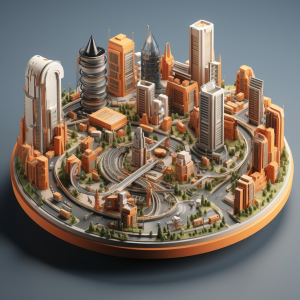
In the modern urban North American landscape, strategic property development stands out as a potent tool for transformative change of our communities. Beyond simply erecting buildings, thoughtful development reshapes neighborhoods, boosts economies, and enhances the quality of life for city dwellers. From revitalizing struggling districts that have seen better days, to introducing sustainable living solutions, the scope of impact is vast and varied.
The Blueprint for Change
The starting point for any strategic development is a comprehensive understanding of the city’s needs and potential. This involves meticulous planning and a clear vision that aligns with the community’s broader goals of urban development, such as accessibility, sustainability, and inclusivity. Developers play a crucial role in this process, acting not just as builders, but as visionaries who foresee and shape the future of urban living.
For instance, developers like Tariq Kassam, a leading figure in Canada’s real estate scene, have started to focus on identifying properties in key urban areas that promise lucrative returns – not only financially, but also in terms of social dividends. Forward-thinking developers have started to favor projects near essential amenities like transit hubs, medical centers, and educational institutions because they allow an authentic community to develop. As a result, property developers like Kassam have requested that federal, provincial, and municipal governments invest in these civic institutions.As a result, these real estate developments not only cater to immediate residential or commercial needs, but also stimulate local economies and encourage further investment.
Economic Revitalization
One of the most evident impacts of effective strategic property development is economic revitalization of a broader community or region. By transforming underused or abandoned areas into thriving business hubs or residential complexes, developers can inject new life into a local economy.
Revitalization results in job creation, both during and after construction, and increased commerce as new businesses and residents move in.
Moreover, these developments often lead to an increase in property values, not just for the new structures but for the surrounding area as well. This uplift can provide a significant boost to local government revenues through increased property taxes, which, in turn, can be reinvested into further urban development projects.
Social and Community Benefits
Beyond economics, strategic property development has profound social implications. By designing inclusive spaces that cater to a diverse population, real estate developers can help to foster stronger community ties and enhance the social fabric of an area. This includes integrating affordable housing units in strategic locations to ensure that growth benefits all socioeconomic groups.
Furthermore, the inclusion of green spaces, public parks, and community centers in development projects can greatly improve the quality of life in a particular area. These features offer residents places to relax, play, and engage with their community, contributing to both mental and physical well-being.
Sustainability and Environmental Impact
Today, sustainable development is no longer optional.. The most successful developers are increasingly adopting green building practices to minimize the environmental impact of their developments. This includes the use of sustainable materials, energy-efficient systems, and designs that maximize natural light and air circulation. Such practices not only reduce the carbon footprint of new buildings, but have the added benefit of generating long-term cost savings for occupants through reduced energy bills.
Additionally, the integration of leading technology in modern developments—such as smart thermostats, energy-efficient appliances, and water-saving fixtures—further enhances the sustainability of urban living spaces.
Challenges and Considerations
While the benefits of strategic property development are significant, the challenges are not trivial. These projects require substantial capital and a high tolerance for risk, especially in markets susceptible to economic fluctuations. And any developer who has been around for at least five years can tell you that those fluctuations happen regularly and suddenly – often with no warning. On top of that, regulatory hurdles can also complicate development timelines and increase costs.
Moreover, there is the issue of community resistance for certain developments, particularly when residents fear gentrification or loss of cultural heritage. As a result, the most successful developers engage with communities early in the process, ensuring that their plans align with the interests and needs of the people who live and work in an area.
The Future of Urban Development
As cities continue to grow and evolve, the role of strategic property development in shaping urban landscapes will only become more critical. Visionary developers like Tariq Kassam understand that their work does more than change city skylines—it changes lives. Through careful planning and a commitment to sustainability and community, they set the stage for cities that not only thrive economically, but are also vibrant, inclusive communities to live in.
Strategic property development is not just about building; it’s about thoughtful growth that considers the past and future, aiming to leave a lasting, positive impact on urban environments and their inhabitants. As such, it is an indispensable tool in the urban planner’s and real estate developer’s kit, capable of transforming cities into models of sustainable, enjoyable, and equitable living.
Information contained on this page is provided by an independent third-party content provider. Binary News Network and this Site make no warranties or representations in connection therewith. If you are affiliated with this page and would like it removed please contact [email protected]



Comments